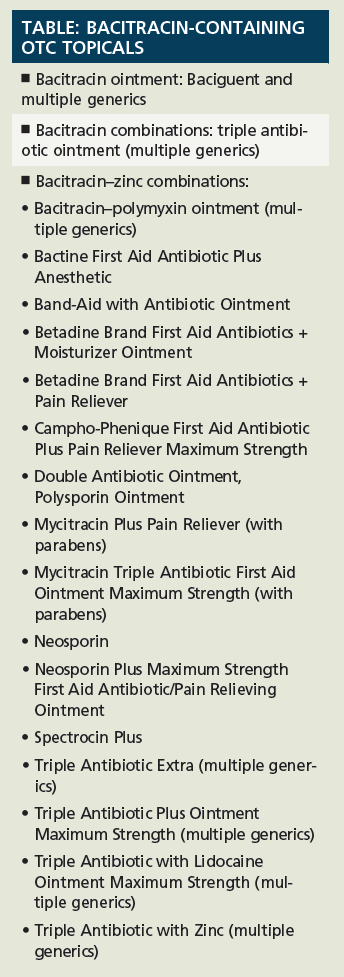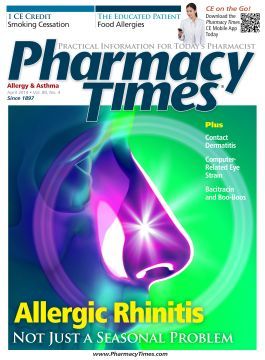Publication
Article
Pharmacy Times
Bacitracin and Boo-Boos: Becoming a No-No
Author(s):
After almost 70 years, bacitracin's good reputation is changing.
After almost 70 years, bacitracin’s good reputation is changing.
In 1945, 7-year-old Margaret Tracey fell in the street and sustained a compound fracture. Filtrate decanted from the dirt from her wound contained a wide, powerful antibiotic spectrum derived from the Tracey I strain of Bacillus subtilis. Hence, its name: bacitracin. This discovery was serendipitous—the wartime physician and bacteriologist who discovered it screened samples of civilians’ contaminated wounds routinely to identify bacteria and saw that agar plate growth from this wound was particularly active.1,2
Systemic administration was impossible (bacitracin is highly nephrotoxic), but its topical use exploded after the FDA approved it in 1948.3,4 Dermatologists embraced it for its topical efficacy and seemingly low rate of allergic reaction compared with penicillin or sulfonamides.5 In the late 1980s, surgeons began using bacitracin-containing ointments as post-surgical wound dressings when they noticed that neomycin caused frequent allergic reactions.6
Today, from the mom whose toddler skins her knee, to the grandpa who tears his fragile skin, everybody seems to know about bacitracin ointment. It remains one of the most frequently prescribed medications in US emergency departments and hospitals. As an OTC drug, it is for the most part unregulated and available in every medicine cabinet and first aid kit.
After almost 70 years, however, bacitracin’s harmless reputation is changing. Numerous reports have found an association between allergic contact dermatitis (ACD) and bacitracin, with the number continuously increasing. Bacitracin ranked as the ninth-most common allergen between 1998 and 2002.7,8 In 2003, the American Contact Dermatitis Association (ACDA) named bacitracin its Allergen of the Year based on increasing reports of allergy and anaphylaxis. By 2010, bacitracin ranked number 3 on the North American Contact Dermatitis Group Patch Test Results, which tests more than 4000 patients across the United States; 9.2% of the patients had a reaction to bacitracin.9 A similar study in Ontario, Canada, in 2010 (n = 102) found that 44% of patients who had previously developed ACD due to any topical agent tested positive to bacitracin; neomycin caused reactions in a comparatively low 29%, mainly because Canadians use very little neomycin.10 The ACDA recommends limiting the use of bacitracin.11
Still a Medicine Cabinet Staple
Despite its high potential to cause allergic reactions, bacitracin is still widely used. Advertisements promote its use as a healing agent directly to consumers, and it’s a fairly routine aftercare item in our tattoo and piercing-obsessed society. Use of an antibacterial ointment by tattoo parlors is required or suggested by some state boards of health (ie, those of Alabama, Arkansas, Hawaii, Maine, Montana, Nevada, New Hampshire, North Carolina, Ohio, South Dakota, Texas, and Utah).12 Tattoo artists discourage their customers from using plain petrolatum because petroleum-based products tend to drain the color from tattoos. They also advise against using Neosporin because it is known to cause allergic reactions that cause tattoo “spotting.” Instead, tattoo artists tend to recommend bacitracin, although they warn tattoo recipients about “weeping tattoo” (fluid leakage from a tattoo during the first several days of healing).13
Bacitracin’s use also continues because no topical emollient is universally recommended for wound care. Despite the fact that dermatologists and public awareness groups have tried to publicize potential problems with bacitracin, 8% to 10% of dermatologic surgeons still use bacitracin postoperatively. Almost half of dermatologic surgeons actively advise patients not to use it because it is unnecessary, which is wise because mass marketing of bacitracin products would have patients believe otherwise.14 The Table lists bacitracin-containing OTC topical products, many of which are also available with a corticosteroid.

Allergic Contact Dermatitis and MoreWhen bacitracin causes cell-mediated ACD (ie, a local delayed hypersensitivity phenomenon10), reactions may include urticaria, swelling, redness, cellulitis, and poor healing. Patients often confuse these with normal or abnormal healing, and so do clinicians. One subtle hint indicates that ACD is more likely than poor healing: ACD is more likely to cause itching, while poor healing is more likely to cause pain or discomfort.11 ACD is confined to the application site initially, but with time or repeated exposure, the reaction may spread to distant sites (auto-eczematization).10Bacitracin can also cause IgE-mediated events (ie, systemic phenomena), including generalized urticaria, sweating, dyspnea, hypotension, and subsequent collapse and potentially life-threatening anaphylactic shock. ACD may precede these dramatic reactions.15 Serious cases have been associated with topical bacitracin on an open wound, intra-operative wound irrigation, breast augmentation, and application on a skin graft in previously sensitized patients.16-23 In most cases of severe systemic reaction, patients remembered prior sensitization or allergic reaction when questioned.What’s the Alternative?In many, if not most, situations in which bacitracin has been used in the past, white petrolatum is a safe, effective alternative.24 Smack et al enrolled 922 patients in a randomized, double-blind, prospective trial; among the patients, 1249 wounds were monitored. The researchers compared white petrolatum with bacitracin ointment and recorded wound infection incidence, ACD incidence, and healing characteristics. White petrolatum was found to be safe and effective and caused no ACD. Among patients treated with bacitracin, 0.9% developed ACD.15 (This study was conducted in 1996; since then, the incidence of bacitracin-induced ACD has increased. If this study were redone today, the rate of ACD would be significantly higher.8,9) In both groups, wound infections and compromised healing occurred at the same rates.15If lubrication is desired, plain white petrolatum is preferable to bacitracin ointment. Most dermatologic surgeons use petrolatum, Aquaphor (which contains lanolin, an allergen for roughly 2.5% of patients), or vitamin E emolient.14 Using any of these agents as wound dressings for clean surgical procedures reduces the chance of adverse reactions, including ACD and life-threatening contact urticaria and anaphylaxis. Clinicians should avoid using bacitracin ointment for routine care or for cleaning surgical wounds. Health care providers should ask about bacitracin allergy before using bacitracin on patients.End NotePharmacists can help educate patients— and health care providers—about topical antimicrobial agents and wound healing. To start, pharmacists can tell patients that wound infection rates are typically very low and that they should use antibiotic ointments only if infection develops.6 Talking about unnecessary use of antibiotics and the high potential for allergic reaction are also timely.As always, recommending an alternative (petrolatum or an allergen-free moisturizer) can help patients make better choices.
Ms. Wick is a visiting professor at the University of Connecticut School of Pharmacy, where she teaches classes addressing the societal concerns about drugs.
References:
- Kinne DW. Aortic surgery: then and now. John Jones Surgical Society Newsletter. 2004;7:1-8.
- Johnson BA, Anker H, Meleney FL. A new antibiotic produced by a member of the B. subtilis group. Science. 1945;102:376-377.
- Sood A, Taylor JS. Bacitracin: allergen of the year. Am J Contact Dermat. 2003;14:3-4.
- National Hospital Ambulatory Medical Care Survey, 1992. Emergency Department Summary Series 13, No. 125 [online database]. Atlanta, GA: United States Department of Health and Human Services website. www.cdc.gov/nchs/ahcd.htm. Accessed February 7, 2014.
- Meleney FL, Johnson BA. Bacitracin. Am J Med. 1949;7:794-806.
- James WD. Use of antibiotic-containing ointment versus plain petrolatum during and after clean cutaneous surgery. J Am Acad Dermatol. 2006;55:915-916.
- Pratt MD, Belsito DV, DeLeo VA, et al. North American Contact Dermatitis Group patch-test results, 2001-2002 study period. Dermatitis. 2004;15:176-183.
- Marks JG Jr, Belsito DV, DeLeo VA, et al; North American Contact Dermatitis Group. North American Contact Dermatitis Group patch-test results, 1998 to 2000. Am J Contact Dermat. 2003;14:59-62.
- Warshaw EM, Belsito DV, Taylor JS, et al. North American Contact Dermatitis Group patch test results: 2009 to 2010. Dermatitis. 2013;24:50-59.
- Spring S, Pratt M, Chaplin A. Contact dermatitis to topical medicaments: a retrospective chart review from the Ottawa Hospital Patch Test Clinic. Dermatitis. 2012;23:210-213.
- Schalock PC, Zug KA. Bacitracin. Cutis. 2005;76:105-107.
- United States tattoo laws. Tatoodesign.com website. www.tattoodesign.com/tattoo_laws/united_states.php. Accessed February 7, 2014.
- Hudson K. Tattoo aftercare: how to take care of your new tattoo. About.com website. http://tattoo.about.com/library/blaftercare.htm. Accessed February 7, 2014.
- Nijhawan RI, Smith LA, Mariwalla K. Mohs surgeons’ use of topical emollients in postoperative wound care. Dermatol Surg. 2013;39:1260-1263.
- Smack DP, Harrington AC, Dunn C, et al. Infection and allergy incidence in ambulatory surgery patients using white petrolatum vs bacitracin ointment: a randomized controlled trial. JAMA. 1996;276:972-1028.
- Cheng CE, Kroshinsky D. Iatrogenic skin injury in hospitalized patients. Clin Dermatol. 2011;29(6):622-632.
- Elsner P, Pevny I, Burg G. Anaphylaxis induced by topically applied bacitracin. Am J Contact Dermatitis. 1990;1:162-164.
- Eedy DJ, McMillan JC, Bingham EA. Anaphylactic reactions to topical antibiotic combinations. Postgrad Med J. 1990;66:858-859.
- Sprung J, Schedewie HK, Kampine JP. Intraoperative anaphylactic shock after bacitracin irrigation. Anesth Analg. 1990;71:430-433.
- Farley M, Pak H, Carregal V, Engler R, James W. Anaphylaxis to topically applied bacitracin. Am J Contact Dermatitis. 1995;6:28.
- Sarayan JA, Dammin TC, Bouras AE. Anaphylaxis to topical bacitracin-zinc ointment. Am J Emerg Med. 1998;16:512-513.
- Gall R, Blakely B, Warrington R. Intraoperative anaphylactic shock from bacitracin nasal packing after septorhinoplasty. Anesthesiology. 1999;91:1545-1547.
- Blas M, Briesacher KS, Lobato EB. Bacitracin irrigation: a cause of anaphylaxis in the operating room. Anesth Analg. 2000;91:1027-1028.
- Mertz PM, Davis SC, Cazzaniga AL, et al. Barrier and antibacterial properties of 2-octylcyanoacrylate-derived wound treatment films. J Cutan Med Surg. 2003;7:1-6.

Newsletter
Stay informed on drug updates, treatment guidelines, and pharmacy practice trends—subscribe to Pharmacy Times for weekly clinical insights.






